instrument panel AUDI A3 2012 Owner´s Manual
[x] Cancel search | Manufacturer: AUDI, Model Year: 2012, Model line: A3, Model: AUDI A3 2012Pages: 280, PDF Size: 70.11 MB
Page 125 of 280
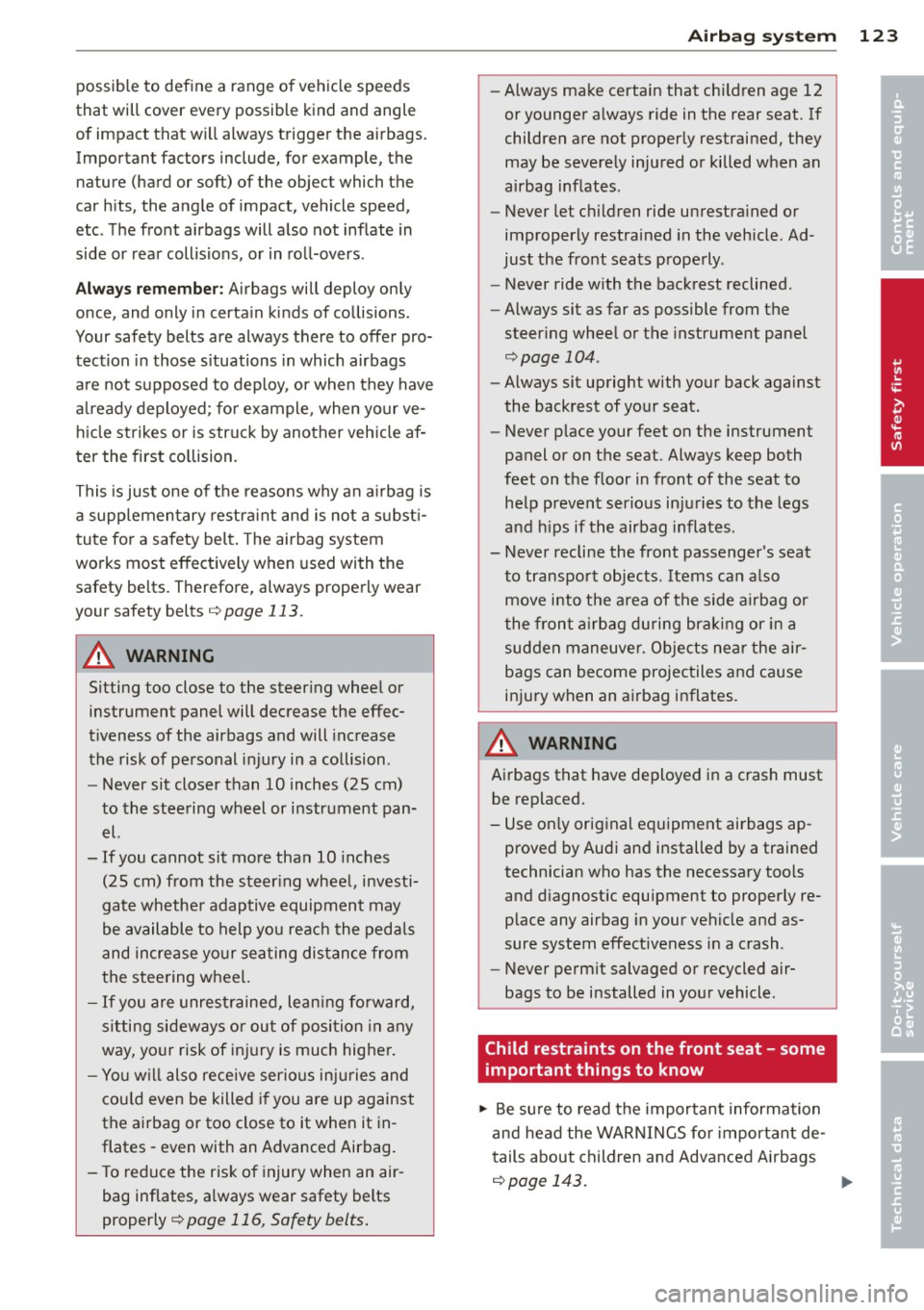
possible to define a range of vehicle spee ds
that will cover every possible kind and angle
of impact that will always trigger the a irbags .
Important fact ors include, for example, the
nature (hard or soft) of the object which the
car hits, the angle of impact, vehicle speed,
etc. The front airbags will also not inflate in
side or rear collisions, or in ro ll-overs .
Alw ay s rem ember : Airbags will deploy only
once, and only in certa in kinds of collisions .
Your safety belts are always there to offer pro
tection in those s ituation s in which airbags
are not supposed to deploy , or when they have
a lready deployed ; fo r example , when yo ur ve
h icle strikes or is struck by another veh icle af
ter the first co llision.
This is just one of the reasons why an a irbag is
a supplementary restra int and is not a s ubst i
tute for a safety belt . The airbag system
works most effectively when used with the
safety belts. Therefore, always properly wear
your safety belts¢
page 113 .
A WARNING
Sitting too close to the steer ing wheel or
instrument panel will decrease the effec
tiveness of the airbags and will increase
the risk of personal injury in a co llision .
- Never sit closer than
10 inches (25 cm)
to the steering wheel or instrument pan el.
- If you cannot sit more than
10 i nches
(25 cm) from the steer ing wheel, investi
gate whether adaptive equipment may
be available to help you reach the pedals
and increase your seating dis tance from
the steering wheel.
- If you are unrestrained, lean ing fo rward,
sitting sideways or out of position in any
way, yo ur risk of inj ury is much highe r.
- You w il l also receive serio us injuries and
cou ld even be killed if you are up against
the airbag or too close to it when it in
flates -even with an Advanced Airbag.
- To reduce the r isk of injury when an air
bag inflates, a lways wear safety belts
properly ¢
page 116, Safety belts .
Airbag system 123
-Always make certain that chi ld ren age 12
or younger a lways ride in the rear seat. If
children are not properly restrained, they may be severe ly inju red or killed when an
airbag inf lates .
- Never let ch ildren ride unrestra ined or
improperly restrained in the vehicle . Ad
just the front seats prope rly .
- Never ride with the backrest reclined.
- Always sit as far as possible from the
steer ing whee l or the instrument pane l
¢page 104.
-Always sit upright with your back against
the backrest of your seat.
- Never p lace your feet on the instrument
panel or on the seat. Always keep both
feet on the f loor in front of the seat to
he lp prevent serio us in ju ries to the legs
and h ips if the airbag inflates.
- Never recline the front passenger 's seat
to transport objects. Items can a lso
move into the area of the s ide a irbag or
the front a irbag du ring bra king or in a
sudde n maneuve r. Obje cts ne ar the air
bags can become projectiles and cause
injury when an airbag inflates.
_&. WARNING ~
A irbags that have de ployed in a crash must
be replaced.
- Use on ly original equipment airbags ap
proved by Audi and installed by a trained
technician who has the necessary too ls
and d iagnost ic equipment to properly re
place any airbag in your vehicle and as
sure system effectiveness in a crash .
- Never perm it salvaged or recycled air
bags to be installed in your vehicle .
Child restraints on the front seat - some
important things to know
.,. Be su re to read t he important information
a nd head the WAR NINGS fo r important de
t ails about children and Advanced A irbags
¢ page 143. ..,.
•
•
Page 126 of 280
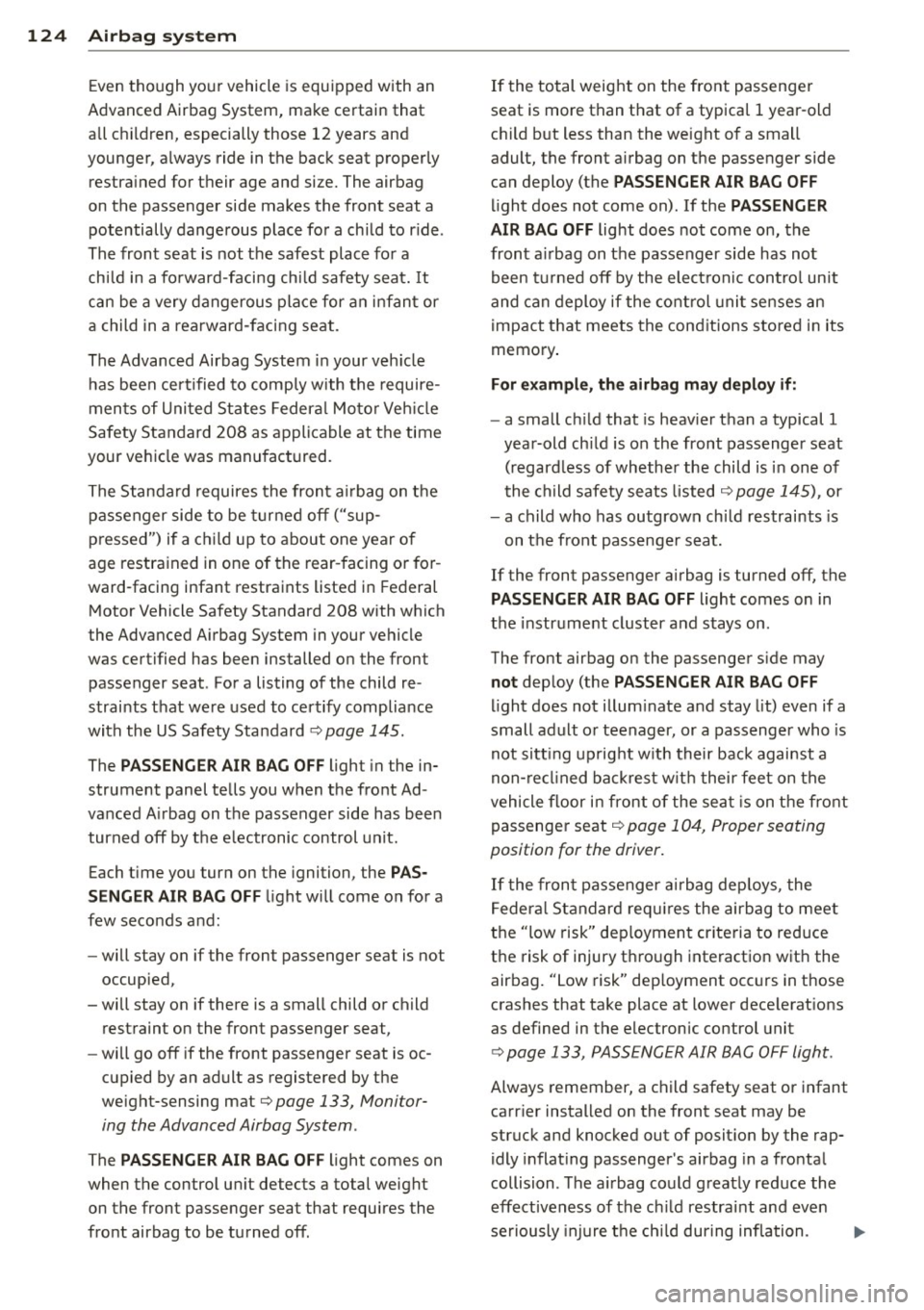
124 Airbag system
Even though your vehicle is equipped with an
Advanced Airbag System, make certain that
all chi ldren, especially those 12 years and
younger, a lways ride in the back seat properly
restrained for their age and size. The airbag
on the passenger side makes the front seat a potentially dangerous place for a ch ild to ride.
The front seat is not the safest place for a
child in a forward-facing child safety seat. It
can be a very dangerous place for an infant or
a child in a rearward-facing seat.
The Advanced Airbag System in your veh icle
has been certified to comply with the require
ments of United States Federal Motor Vehicle
Safety Standard 208 as applicable at the time
your vehicle was manufactured.
The Standard requires the front a irbag on the
passenger side to be turned off ("sup
pressed") if a child up to about one year of
age restrained in one of the rear-facing or for
ward -facing infant restraints listed in Federal
Motor Vehicle Safety Standard 208 with which
the Advanced Airbag System in your vehicle
was certified has been installed on the front passenger seat . For a listing of the child re
strai nts that we re used to certify compliance
with the US Safety Standard
r=v page 145.
The PASSENGER AIR BAG OFF light in the in
strument panel te lls you when the front Ad
vanced A irbag on the passenger side has been
turned off by the e lectronic control unit.
Each t ime you turn on the ignition, the
PAS
SENGER AIR BAG OFF
light will come on for a
few seconds and:
- will stay on if the front passenger seat is not
occupied,
- will stay on if there is a small child or child restraint on the front passenger seat,
- wi ll go off if the front passenger seat is oc
cupied by an adult as registered by the
weight-sensing mat
r=v page 133, Monitor
ing the Advanced Airbag System .
The PASSENGER AIR BAG OFF light comes on
when the control un it detects a total weight
on the front passenger seat that requires the
front airbag to be turned off.
If the total weight on the front passenge r
seat is more than that of a typica l 1 year -old
chi ld but less than the weight of a small
adult, the front airbag on the passenger side
can deploy (the
PASSENGER AIR BAG OFF
light does not come on). If the PASSENGER
AIR BAG OFF
light does not come on, the
front airbag on the passenger side has not
been turned off by the electronic con trol unit
and can deploy if the control unit senses an
impact that meets the cond itions stored in its
memory .
For example, the airbag may deploy if:
-a small ch ild that is heav ier than a typical 1
year-old ch ild is on the front passenger seat
( re gard less of whether the child is in one of
the child safety seats listed
r=v page 145), or
- a child who has outgrown ch ild restraints is
on the front passenger seat.
If the front passenger airbag is turned off, the
PASSENGER AIR BAG OFF light comes on in
the instrument cluster and stays on.
The front airbag on the passenger s ide may
not deploy (the PASSENGER AIR BAG OFF
light does not illum inate and stay lit) even if a
small adult or teenager, or a passenger who is
not sitting upright with their back against a
non-reclined backrest with their feet on the
vehicle floor in front of the seat is on the front
passenger seat
r=v page 104, Proper seating
position for the driver.
If the front passenger airbag deploys, the
Federal Standard requires the airbag to meet
the "low risk" deployment criteria to reduce
the risk of injury t hroug h interaction with the
airbag. "Low risk" deployment occurs in those
crashes that take place at lower dece lerat ions
as defined in the electronic control unit
r=v page 133, PASSENGER AIR BAG OFF light .
Always remember, a child safety seat or infant
carr ier installed on the front seat may be
struck and knocked out of posit ion by the rap
idly inflat ing passenger's airbag in a frontal
collision . The air bag could greatly reduce the
effectiveness of the ch ild restraint and even
seriously injure the child during inflation .
Page 128 of 280
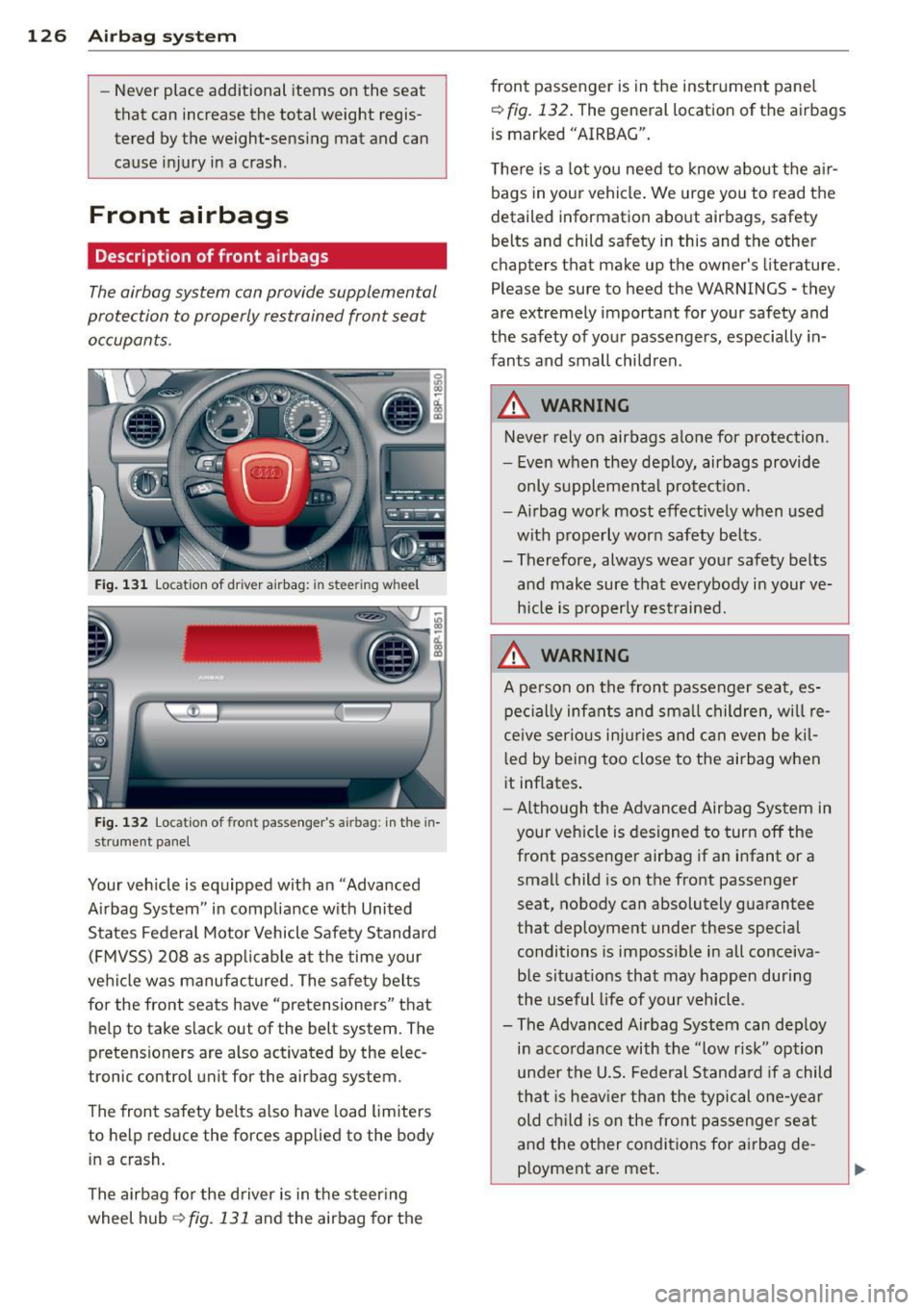
126 Airbag system
-Never place additiona l items on the seat
that can increase the total weight regis
tered by the weight-sensing mat and can
cause injury in a crash.
Front airbags
Description of front airbags
The airbag system can provide supplemental
protection to properly restrained front seat
occupants.
F ig . 131 Location of driver airbag: in steer ing whee l
Fig. 132 Location of front passenger's airbag: in the in
strument panel
Your veh icle is equipped with an "Advanced
A irbag System" in compliance with United
States Federal Motor Vehicle Safety Standard ( FM VSS) 208 as app licab le at the time your
ve hicl e was manufac tured. The safe ty belts
for the front seats have "pretensioners" that
he lp to take slack out of the belt system. The
pretensioners are also activated by the elec
tronic control unit for the airbag system.
The front safety be lts a lso have load limiters
to help reduce the forces applied to the body
i n a crash.
The airbag fo r the driver is in t he s teer ing
wheel hub¢
fig. 131 and the airbag for the front passenger is in the
instrument panel
¢
fig. 132 . The general location of the airbags
is marked "AIRBAG".
T here is a lot you need to know about the a ir
bags in your vehicle. We urge you to read the
detailed information about airbags, safety
belts and child safety in this and the other
chapters that make up the owner's literature.
Please be sure to heed the WARNINGS - they
are extremely important for your safety and
the safety of you r passengers, especially in
fants and small children.
_&. WARNING
Neve r rely on airbags a lone for p rotection.
- Even when they deploy, airbags provide
only supplemental protect ion.
- Ai rbag work most effectively when used
with properly worn safety belts.
- Therefore, always wear your safety belts
a nd make sure that eve rybody in your ve
h icle is p roperly restrained.
_&. WARNING
=
A pe rson on the front passenger seat, es-
pe cial ly infants and sma ll children, w ill re
ce ive ser io us in ju ries and can even be kil
l ed by being too close to the airbag when
it inflates .
- Altho ugh the Advanced Airbag Sys tem in
your vehicle is designed to tur n off the
front passenger airbag if a n in fant or a
sma ll child is on the front passenger
seat, nobody can absolutely guarantee
that deployment under these special
conditions is imposs ible in all conceiva
b le si tua tions that may happen during
the useful life of your v ehicle.
- The Advanced Airbag System can dep loy
i n acco rdance with the "low risk" option
unde r the U.S. Fede ral Standa rd if a child
t hat is heav ie r th an the typical o ne-year
old ch ild is on the front passenger seat
and the other conditions for ai rbag de
p loyment are met .
Page 129 of 280
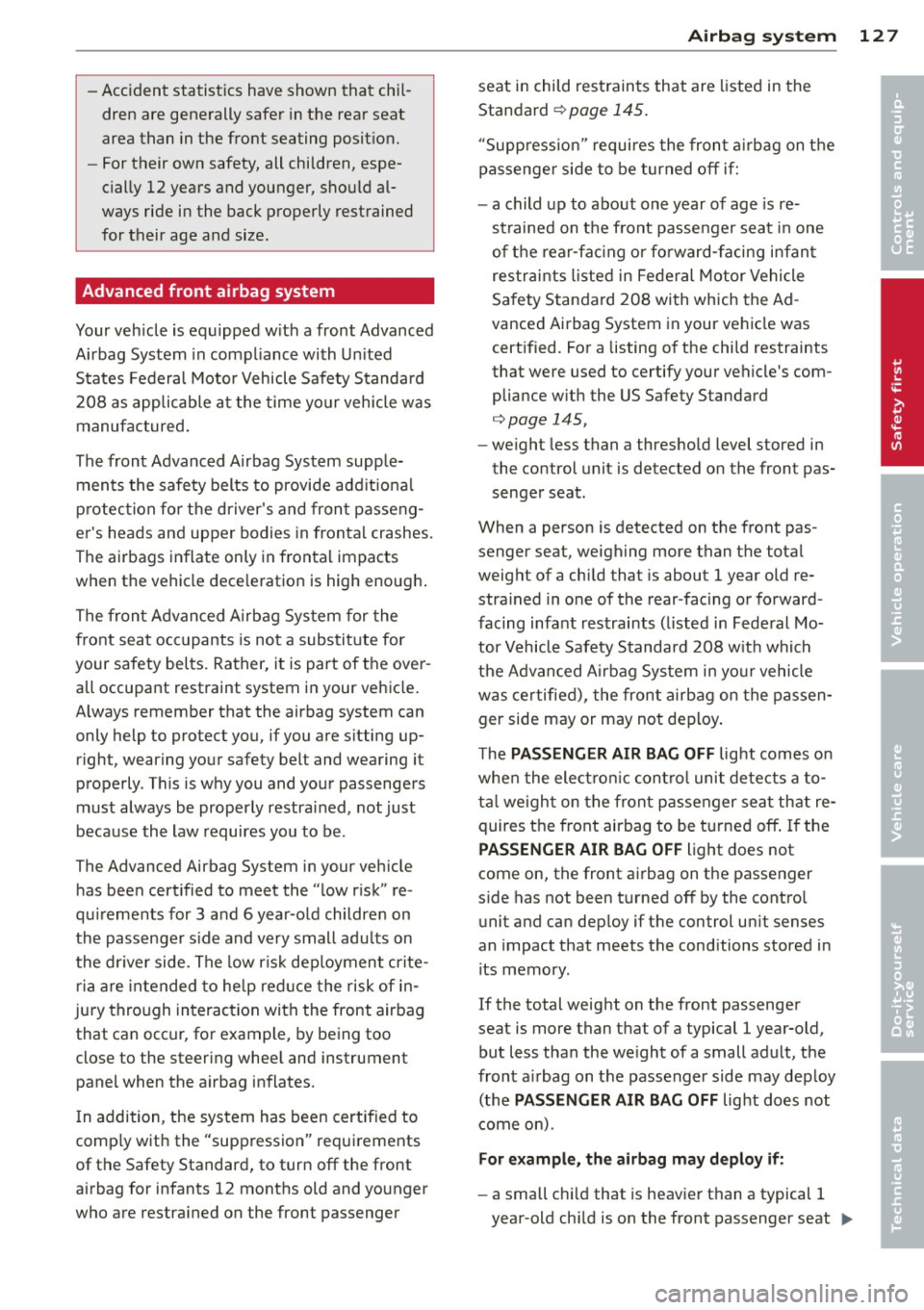
-Accident statistics have shown that chil
dren are generally safer in the rear seat
area than in the front seating posit ion.
- For their own safety, all children, espe
cially 12 years and younger, sho uld al
ways ride in the back properly restrained
for their age and size.
Advanced front airbag system
Your veh icle is equipped w ith a front Advanced
A irbag System in compliance with Un ited
States Federal Motor Vehicle Safety S tanda rd
208 as applicab le a t the time your vehicle was
manufac tured .
The front Advanced Airbag System supple ments the safety belts to provide add it iona l
p rotection fo r the driver's and fron t passeng
e r' s heads and upper bodies in fronta l crashes.
The airbags inflate only in frontal impacts
when the vehicle dece leration is high enough .
The fron t Advanced A irbag Sys tem for the
front seat occ upants is no t a substi tute for
your safety bel ts. Rather, it is part of the over
a ll occupa nt restraint system in your vehicle.
A lways remember that the airbag system can
only help to protect you, if you are s itting up
right, wearing your safety belt and wearing it
properly . This is w hy you and your passenge rs
must always be properly restrai ned, not just
because the law requires you to be .
The Advanced Airbag System i n your veh icle
has been certified to meet the " low r isk" re
qu irements for 3 and 6 year-o ld childre n on
the passenger s ide and very small adu lts on
the dr iver side. The low ris k dep loymen t cr ite
ria are intended to he lp red uce the risk of i n
j ury thro ugh in teraction with the front airbag
that can occ ur, fo r example, by being too
close to the steering whee l and instrument
panel when the airbag inflates.
I n addition, the sys tem has been certif ied to
comp ly with the "suppression" requirements
of the Safety Standard, to turn off the front
airbag for infants 12 months old and younger
who are restra ined on the front passenger
A irbag system 127
seat in child rest raints that are listed in the
Standard
¢ page 145 .
"Supp ress ion" requi res the fron t airbag on t he
passenge r sid e to be turned off if:
- a child up to abo ut one year of age is re
strained on the front passenger seat in one
of t he rear-fa cing o r fo rward -f a cing infan t
res traints listed in Federal Motor Vehicle
Safety Standard 208 with which the Ad
vanced Airbag System in your ve hicle was
cert ified. For a listing o f the chi ld restraints
that were used to certify your vehicle's com
pliance w ith the US Safety Standard
¢page 145,
- weight less than a thresho ld level stored in
the control unit is detected on the front pas
senge r seat.
When a person is detected on the front pas
senger seat, weighing more than the total
weight of a chi ld that is about 1 year old re
stra ined in one of the rear -fac ing or forward
facing infant restraints ( listed in Fede ral Mo
tor Vehicle Safety Standard 208 with whic h
t h e Advanced A irbag Sys tem in yo ur vehicle
was certified), the fron t airbag on the passen
ger side may or may not dep loy .
T he
PASSENGER AIR BAG OFF lig ht comes o n
whe n the elect ro nic cont ro l unit de tects a to
ta l we igh t on the front p assenger sea t that re
quires the front airbag to be t urned off .
If the
PASSENGER AIR BAG OFF light does not
come on, the front ai rbag on the passenger
s ide has not been t urned off by the contro l
u nit and can dep loy if the control un it senses
an impact that meets the cond itions stored i n
its memory .
If the total weight on the front passenger
seat is more than that of a typical 1 year-old,
but less than the we ight of a small adu lt, the
front a irbag on t he passenger side may dep loy
(the
PASSENGER AIR BAG OFF light does not
come on) .
For example, the airbag may deploy if:
-a small chi ld that is heav ie r than a typical 1
year-old ch ild is on the front passenger seat ..,. •
•
Page 130 of 280
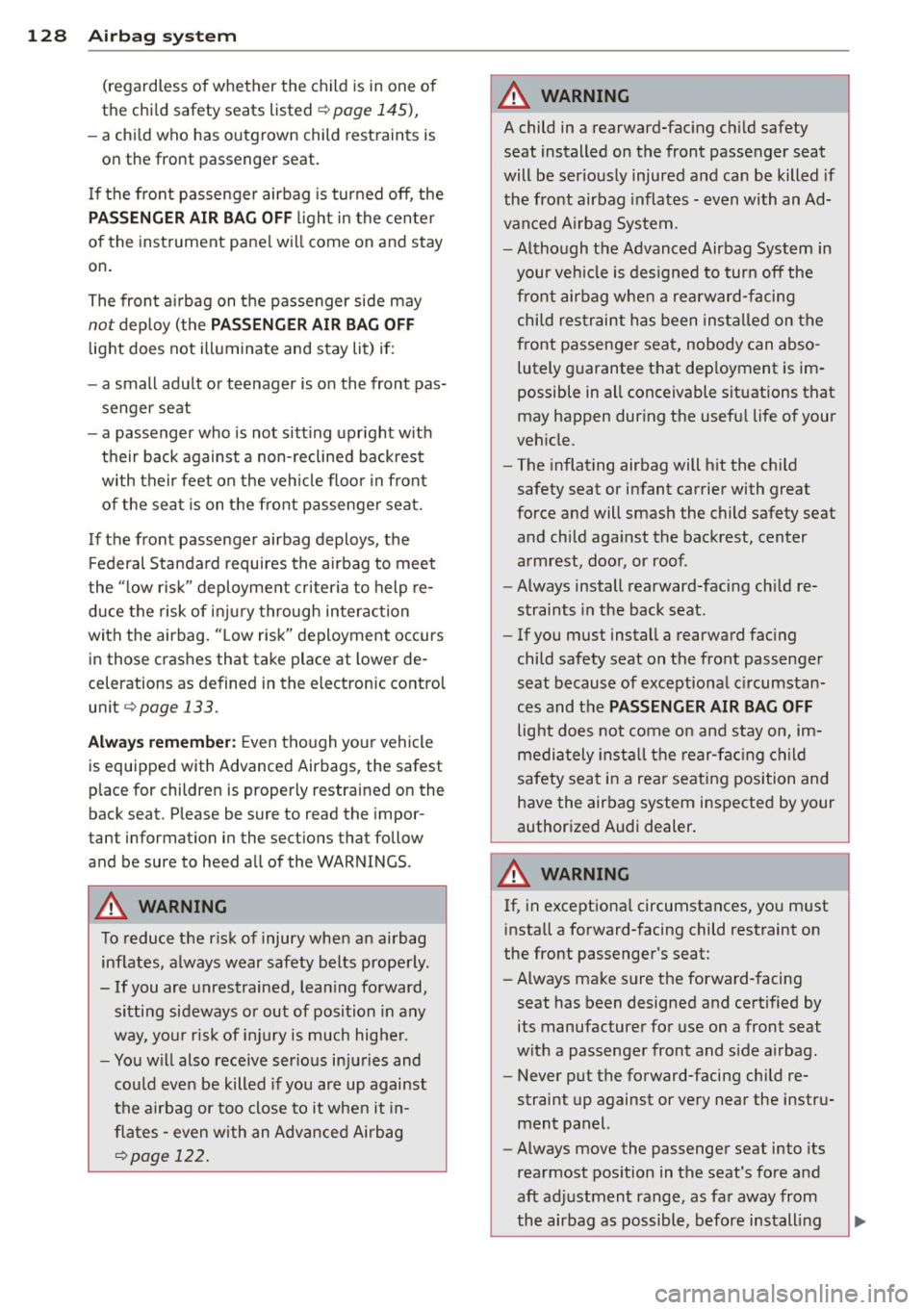
128 Airbag sys tem
(regar dless of whe ther the chil d is in one of
the ch ild safety seats listed
¢ pa ge 14 5),
- a chi ld w ho has outgrown child rest raints is
on the front passenger seat.
I f the front passenger airbag is turned
off , the
PASSEN GER AIR BA G OFF light in the cen ter
of the instrument pane l will come on and stay
on.
The front a irbag on the passenger side may
not deploy (the PA SSENGER AIR BAG OFF
light does not illuminate and stay lit) if:
- a small adu lt or teenager is o n the front pas
senger seat
- a passenger who is not sitt ing upr ight w ith
their back against a non-reclined backrest
with their feet on the veh icle floo r in front
of the sea t is on the front passenger seat.
I f the front passenger airbag deploys, the
F ederal Standard requires the airbag to meet
the " low risk " deployment criteria to help re
d uce the risk of in jury through in terac tion
with the airbag. " Low risk" deployment occurs
in those crashes that take place at lower de
celerations as defined in the e lectronic contro l
un it
q page 133.
Alwa ys remember: Even tho ugh you r vehicle
is equipped with Advanced Airbags, the safest
p lace for children is properly restrained on the
back seat. Please be sure to read the impo r
tant information in the sect ions that follow
and be sure to heed a ll of the WARNINGS .
A WARNING
To reduce the risk of injury when an airbag
inflates, a lways wear safety belts prope rly .
- If you are unrestrained, lean ing forward,
sitting sideways or out of position in any
way, your risk of injury is much higher.
- You w ill also receive serio us in juries and
cou ld even be killed if you are up against
the a irbag or too close to it when it in
fla tes - even with an Adv ance d Airbag
qpage 122.
A WARNING
A child in a rearward-fac ing ch ild safety
seat installed on the front passenger seat
will be serious ly injured and can be killed if
the front airbag inflates - even with an Ad
van ced A irbag System.
- Altho ugh the Advanced Airbag System in
your veh icle is designed to tur n
off the
front air bag when a rearward-facing
child res traint has been instal le d on the
front passenger seat, nobody can abso
lutely g uarantee that dep loyment is im
possible in all conceivable situations that
may happen dur ing the usefu l life of your
veh icle.
- The inflating airbag will h it the ch ild
safety seat or infant carrier with great
force and will smash the child safety seat
and child aga inst the backrest, center
armrest, doo r, or roof.
- Always install rearward-facing ch ild re
straints in the back seat.
- If you must install a rearward fac ing
child safety seat on the front passenger
seat because of exceptiona l circumstan
ces and t he
PASSENGER AIR BAG OFF
light does not come on and s tay on, im
mediately inst all the rear-fac ing c hild
safety seat in a rear seating position and
have the air bag system inspected by your
author ized Audi dealer .
A_ WARNING
If, in exceptiona l circumstances, you m ust
i nsta ll a forward-facing child restraint on
the front passenger's seat:
- Always make sure the forward-facing
seat has been designed and certified by its manufacturer for use on a front seat
with a passenger front and s ide a irbag .
- Never p ut the fo rward-facing child re
straint up against or very near the instru
ment panel.
- Always move the passenger seat into its
rearmost pos ition in the seat's fore and
aft ad justmen t range, as fa r away from
the airbag as possible, before ins talling
Page 131 of 280

the forward-facing child restraint. The backrest must be adjusted to an upr ight
posit ion.
- Make sure that the
PASSENG ER AI R BA G
OFF
light comes on and stays on all the
t ime whenever the ignition is switched
on.
Advanced Airbag System components
The front passenger seat in your vehicle has a
l ot of very important parts of the Advanced
Airbag System in it. These parts include the
weight-sens ing ma t, sensors, wiring, brack
ets, and mo re. The function of the system in
the front passenger seat is checked by the
e lectronic control unit when the ignition is on .
The control unit monitors the Advanced Air bag System and turns the airbag indicator
light on when a malfunction in the system
components is detected. The function of the
airbag ind icator light is described in greater
deta il below. Because the front passenger
seat contains impo rtant parts of the Ad
vanced A irbag System, you m ust take care to
p revent it from being damaged. Damage to
the seat may prevent the Advanced Airbag for
the front passenger seat from doing its job in
a crash .
The front Advanc ed Airbag Syst em
con sis ts o f th e following :
-Crash sensors in the front of the vehicle that
measure vehicle acceleration/deceleration
to provide information to the Advanced Air bag System about the severity of the crash.
-An electronic control unit, with integrated
crash sensors for front and side impacts .
The cont ro l unit "decides" whether to fire
the front airbags based on the information r eceived from the c rash sensors. The control
unit a lso "dec ides" whet her the safety be lt
pretensione rs should be activated.
- An Advanced Airbag with gas generator for
the d river ins ide the steer ing whee l hub.
- An Advanced Airbag with gas generator in
s ide t he instr ument pane l for the front pas
senger.
A irbag system 129
- A weight-sensing mat under the upho lstery
padding of the front passenger seat cushion
that measures the total weight on the seat .
The informat ion reg istered is sent continu
ously to the electron ic control unit to regu
late deployment of the front Advanced Air
bag on the passenger side.
- An airbag monitoring system and ind icator
light in the instrument cluster
¢page 133.
-The PASSENGER AIR BAG OFF light comes
on and stays on in the center of the instru
ment panel
c:::> page 133, fig . 134 and tells
you when the front Advanced Airbag on the passe nger side has been tu rned off.
- A senso r below the safety belt latch fo r the
front seat passenger to measure the tension
on the safety be lt. T he ten sion on the safety
be lt and the weight regis tered by the
weight -sensing mat he lp the control unit
"decide" whether the front airbag fo r the
front passenger seat should be turned off or not
¢ page 123, Child restraints on the
front seat -some important things to
know.
-A sensor in the safety belt latch for the driv
er and for the front seat passenger that
senses whether that safety belt is latched or
not and transmits this information to the
electronic contro l un it .
A WARNING
D amage to the front passenger seat can
p revent the front airbag from wor king
properly.
- Imp roper repai r or d isassembly of the
fr on t passenge r and dr iver seat will pre
vent the Advanced Airbag System from
functioning p roperly.
- Repairs to the front passenger seat must
be pe rformed by qualified and p roperly
trained workshop personne l.
- Never remove the front passenger or driver seat from the vehicle .
- Never remove the upho lstery from the
front passenger seat .
- Never disassemble or remove p arts from
-
the sea t or disconnect wires from it. ..,.
•
•
Page 134 of 280
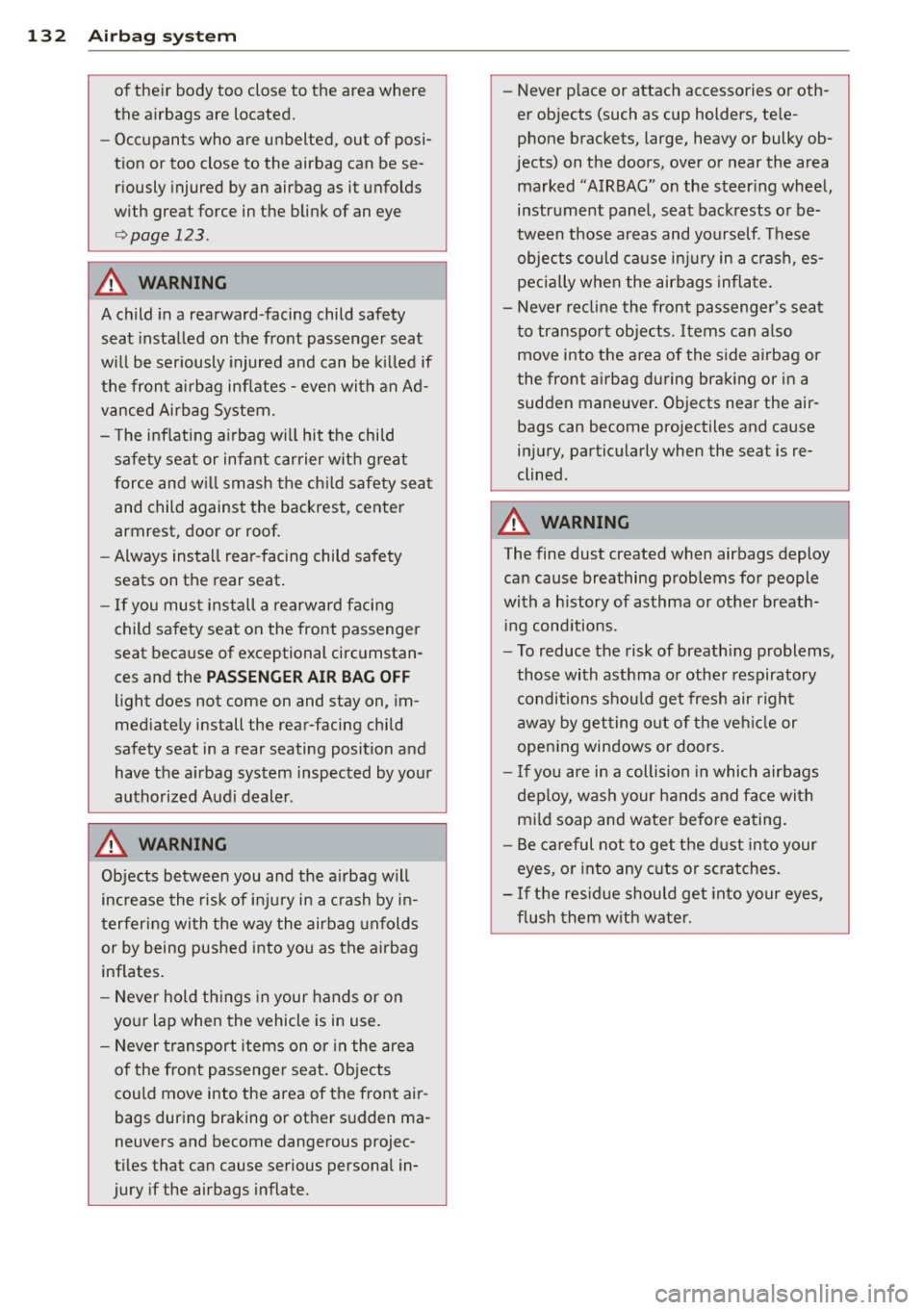
132 Airbag system
of their body too close to the area where
the airbags are located.
- Occupants who are unbelted, out of posi
tion or too close to the airbag can be se riously injured by an airbag as it unfolds
with great force in the blink of an eye
r=> page 123 .
A WARNING
A child in a rearward-facing child safety
seat installed on the front passenger seat
will be seriously injured and can be killed if
the front airbag inflates -even with an Ad
vanced Airbag System.
- The inflating airbag will hit the child
safety seat or infant carrier with great
force and will smash the child safety seat
and child against the backrest, center armrest, door or roof.
- Always install rear-facing child safety
seats on the rear seat.
- If you must install a rearward facing
child safety seat on the front passenger
seat because of exceptional circumstan ·
ces and the
PASSENGER AIR BAG OFF
light does not come on and stay on, im
mediately install the rear-facing child
safety seat in a rear seating position and
have the airbag system inspected by your
authorized Audi dealer .
A WARNING
Objects between you and the airbag will
increase the risk of injury in a crash by in
terfering with the way the airbag unfolds
or by being pushed into you as the airbag
inflates.
- Never hold things in your hands or on
your lap when the vehicle is in use .
- Never transport items on or in the area
of the front passenger seat. Objects
could move into the area of the front air
bags during braking or other sudden ma
neuvers and become dangerous projec
tiles that can cause serious personal in
jury if the airbags inflate.
-
- Never place or attach accessories or oth
er objects (such as cup holders, tele
phone brackets, large, heavy or bulky ob
jects) on the doors, over or near the area
marked "AIRBAG" on the steering wheel,
instrument panel, seat backrests or be
tween those areas and yourself . These
objects could cause injury in a crash, es
pecially when the airbags inflate.
- Never recline the front passenger's seat
to transport objects. Items can also
move into the area of the side airbag or
the front airbag during brak ing or in a
sudden maneuver. Objects near the air
bags can become projectiles and cause
injury, particularly when the seat is re
clined.
A WARNING
-T he fine dust created when airbags deploy
can cause breathing problems for people
with a history of asthma or other breath
ing conditions.
= To reduce the risk of breathing problems ,
those with asthma or other respiratory
conditions should get fresh air right
away by getting out of the vehicle or
opening windows or doors.
- If you are in a collision in which airbags
deploy, wash your hands and face with
mild soap and water before eating.
- Be careful not to get the dust into your
eyes, or into any cuts or scratches.
- If the residue should get into your eyes ,
flush them with water.
Page 136 of 280

134 Airbag sys te m
Advanced Airbag System in your vehicle was
certified.
I f the front passenger seat is not occ upied,
the front airbag will not deploy, and the
PAS·
SENGER AIR B AG OFF
light will stay on. Nev
er insta ll a rearward-facing child restraint on
the front passenger seat, the safest place for
a child in any kind of child restraint is at one
of the seat ing positions on the rear seat
c:> page 123, Child restraints on the front seat
- some important things to know
and
c:> page 143, Child Safety .
If the PASSENGER AIR BAG OFF light comes
on
when one of the conditions listed above is
met, be sure to check the light regularly to
make certa in that the
PAS SENGER AIR BAG
OFF
light stays on cont inuous ly whenever the
i gnit ion is on.
If the PAS SENGER AIR BAG
OFF
li ght does not appear on and does not
stay on all the time, stop as soon as it is safe
to do so and
- react iva te the system by turning the ignition
off and then turning it on again;
- remove and re insta ll the chi ld restraint.
Make su re that the child res traint is properly
insta lled and that the safety be lt for the
front passenger seat has been correct ly
ro uted throug h the child restraint as descri
bed in the chi ld restraint man ufacturer's in
structions;
- make sure that the convertible locking fea
ture on the safety be lt for the front passen
ger seat has been activated and that the
safety belt has been pulled tight. The belt must not be loose or have loops of slack so
t h at the sensor below the safety be lt latch
on the sea t can do its job
¢ page 152.
- make sure that th ings that may increase the
we ight of t he chi ld and child safety seat are
not be ing tra nspo rted on the front passen
ger seat;
- make su re that the safety be lt tension sen
so r is not b locked. Shake t he safety be lt
l atch on the front passenger seatbac k and
forth;
- If a st rap or te ther is being used to tie the
child safety seat to the front passenger seat, make sure that
it is not so tight that it
causes the weight-sensing mat to measure
more weight than is act ually on the seat.
If the PASSENGER AIR BAG OFF light still
does not come on
and does not stay on con
tin uous ly (when the ignition is switched on),
- t ake the child res train t off the front passen-
ge r seat and ins tall it properly at one of the
rear seat positions. Have the airbag system
inspected by your authorized Audi dea ler
immed iate ly .
- move the child to a rear seat position and
make sure t hat the c hild is properly restra in
ed in a ch ild restra int that is appropriate for
its size and age.
The
PASSENGER AIR BAG OFF light should
NOT come on when t he ignit ion is on and an
adult is s itting in a proper seating position on
the front passenger seat. If the
PASSENGER
AIR BAG OFF
light comes on and stays on or
flashes fo r about 5 seconds wh ile driving, un
der these c ircumstances, make sure that:
- the adult on the front passenger seat is
properly seated on the center of the seat
cushion with his or her back up aga inst the
backrest and the backrest is not recl ined
c:> page 104, Proper seating position for the
driver,
- the adult is not tak ing weight off the seat by
holding on to the passenger assist handle
above the fron t passenger door or s upport
ing their weight on the armres t,
- t he safety belt is be ing properly wo rn and
t hat the re is not a lot o f slack in the safety
be lt webb ing,
- accessory seat covers or cushions or othe r
t hings tha t may cause an incorrec t reading
or impression on the weight-sensing mat
under the upho lstery of the seat have been
removed from the front passenger seat,
- a safety belt extender has not been left in
the safety belt latch for the front passenger
seat.
In add ition to the
PASSENGER AIR BAG OFF
light in the center of the instrument panel,
the message
PASSENGER AIR BAG OFF or
Page 138 of 280
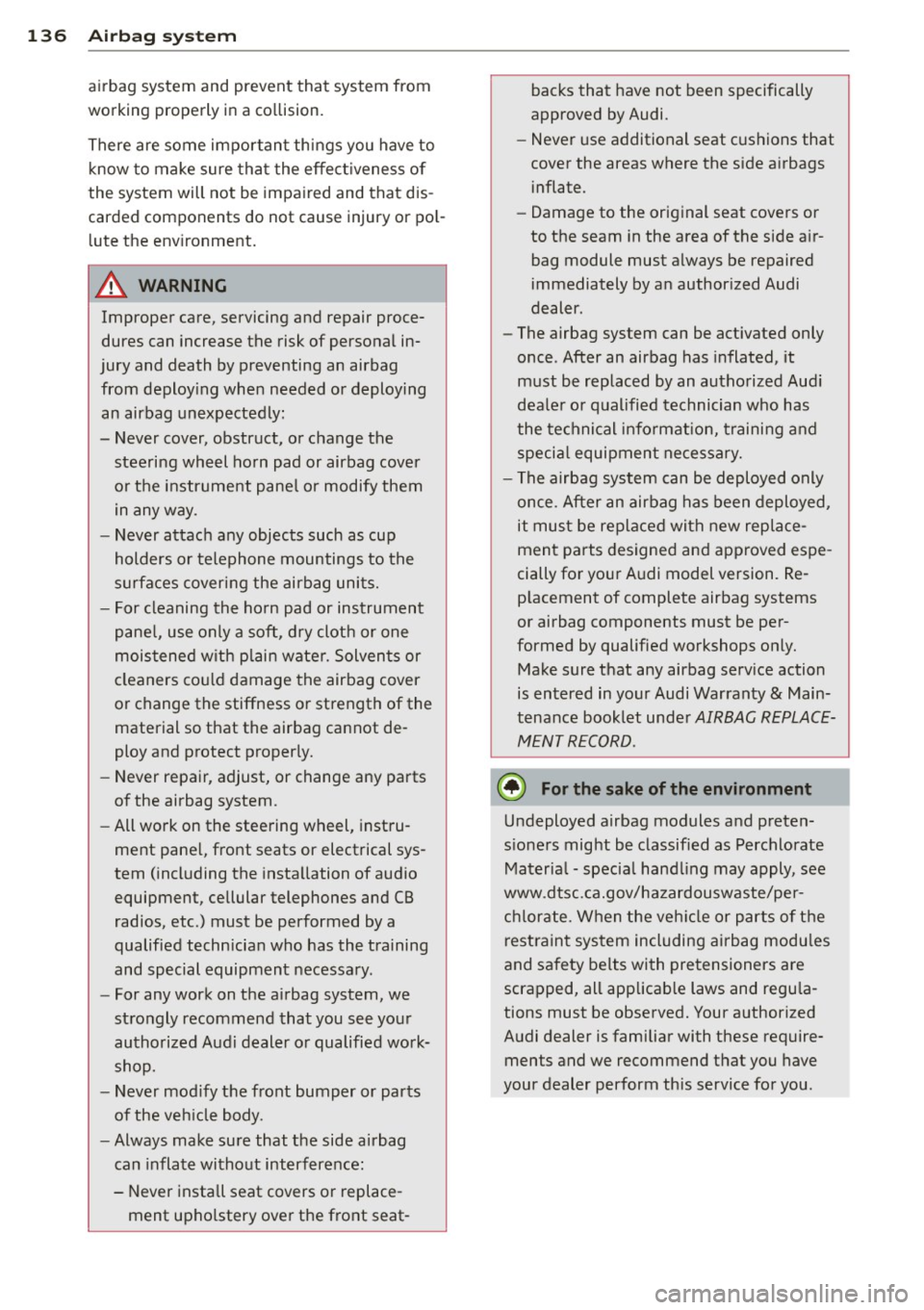
136 Airbag system
airbag system and prevent that system from
working properly in a collision.
There are some important things you have to know to make sure that the effectiveness of
the system will not be impaired and that dis
carded components do not cause injury or pol
lute the environment.
.&_ WARNING
Improper care, servicing and repair proce
dures can increase the risk of personal in
jury and death by preventing an airbag
from deploying when needed or deploying an airbag unexpectedly:
- Never cover, obstruct, or change the steering wheel horn pad or airbag cover
or the instrument panel or modify them
in any way.
- Never attach any objects such as cup
holders or telephone mountings to the
surfaces covering the airbag units.
- For cleaning the horn pad or instrument
panel, use only a soft, dry cloth or one
moi5tened with plain water. Solvent5 or
cleaners could damage the airbag cover
or change the stiffness or strength of the
material so that the airbag cannot de
ploy and protect properly.
- Never repair, adjust, or change any parts
of the airbag system .
- All work on the steering wheel, instru
ment panel, front seats or electrical sys
tem (including the installation of audio
equipment, cellular telephones and CB
radios, etc .) must be performed by a
qualified technician who has the training
and special equipment necessary.
- For any work on the airbag system, we
strongly recommend that you see your authorized Audi dealer or qualified work
shop.
- Never modify the front bumper or parts
of the vehicle body .
-Always make sure that the side airbag
can inflate without interference:
- Never install seat covers or replace
ment upholstery over the front seat- backs that have not been specifically
approved by Audi.
- Never use additional seat cushions that
cover the areas where the side airbags
inflate.
- Damage to the original seat covers or
to the seam in the area of the side air
bag module must always be repaired
immediately by an authorized Audi
dealer .
- The airbag system can be activated only
once . After an airbag has inflated, it
must be replaced by an authorized Audi
dealer or qualified technician who has
the technical information, training and
special equipment necessary.
- The airbag system can be deployed only
once. After an airbag has been deployed,
it must be replaced with new replace
ment parts designed and approved espe
cially for your Audi model version. Re
placement of complete airbag systems
or airbag components must be per
formed by qualified workshops only. Make sure that any airbag service action
is entered in your Audi Warranty
& Main
tenance booklet under
AIRBAG REPLACE
MENT RECORD .
@ For the sake of the environment
Undeployed airbag modules and preten
sioners might be classified as Perchlorate
Material - special handling may apply, see
www .dtsc .ca.gov/hazardouswaste/per
chlorate. When the vehicle or parts of the restraint system including airbag modules
and safety belts with pretensioners are
scrapped, all applicable laws and regula
tions must be observed. Your authorized
Audi dealer is familiar with these require ments and we recommend that you have
your dealer perform this service for you.
Page 146 of 280

144 Child Safety
-Always install rear-facing child safety
seats on the rear seat.
- If you must install a rearward facing
child safety seat on the front passenger
seat in exceptional circumstances and
the
PASSENGER AIR BAG OFF light does
not come on and stay on, immediately
install the rear-facing child safety seat in
a rear seating position and have the air
bag system inspected immediately by
your authorized Audi dealer.
_& WARNING
If, in exceptional circumstances, you must
install a forward-facing child restraint on
the front passenger's seat:
- Always make sure the forward-facing
seat has been designed and certified by
its manufacturer for use on a front seat
with a passenger front and side airbag.
- Always follow the manufacturer's in
structions provided with the child safety
seat or carrier.
- Always move the passenger seat into its
rearmost position in the seat's fore and
aft adjustment range, as far away from
the airbag as possible before installing
the child restraint. The backrest must be adjusted to an upright position .
- Always make sure that the
PASSENGER
AIR BAG OFF
light comes on and stays
on all the time whenever the ignition is
switched on.
(D Tips
Always replace child restraints that were
installed in a vehicle during a crash. Dam
age to a child restraint that is not visible
could cause it to fail in another collision
situation.
Advanced front airbag system and children
Your vehicle is equipped with an "Advanced
Airbag System" in compliance with United
States Federal Motor Vehicle Safety Standard (FMVSS) 208 as applicable at the time your
vehicle was manufactured.
The Advanced Airbag system in your vehicle
has been certified to meet the "low-risk" re
quirements for 3- and 6-year old children on
the passenger side and small adults on the driver side. The low risk deployment criteria
are intended to reduce the risk of injury
through interaction with the airbag that can
occur, for example, by being too close to the
steering wheel and instrument panel when
the airbag inflates . In addition, the system
has been certified to comply with the "sup
pression" requirements of the Safety Stand
ard, to turn off the front airbag for infants up
to 12 months who are restrained on the front
passenger seat in child restraints that are list
ed in the Standard.
Even though your vehicle is equipped with an
Advanced Airbag system , all children, espe
cially those 12 years and younger, should al
ways ride in the back seat properly restrained
for their age and size. The airbag on the pas
senger side makes the front seat a potentially dangerous place for a child to ride . The front
seat is not the safest place for a child in a for
ward-facing child safety seat. It can be a very
dangerous place for an infant or a larger child
in a rearward-facing seat .
Advanced Airbags and the weight
sensing mat in the front seat
The Advanced Airbag System in your vehicle
detects the presence of an infant or child in a
child restraint on the front passenger seat us
ing the weight-sensing mat in the seat cush
ion and the sensor below the safety belt latch
on the front passenger seat that measures the
tension on the safety belt.
The weight -sensing mat measures total
weight of the child and the child safety seat
and a child blanket on the front passenger
seat. The weight on the front passenger seat
is related to the design of the child restraint
and its "footprint", the size and shape of the
bottom of the child restraint as it sits on the .,..